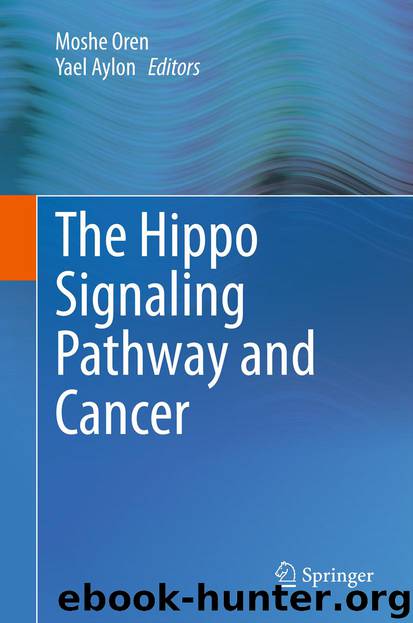The Hippo Signaling Pathway and Cancer by Moshe Oren & Yael Aylon

Author:Moshe Oren & Yael Aylon
Language: eng
Format: epub
Publisher: Springer New York, New York, NY
9.3 The Non-receptor Tyrosine Kinase c-Abl; Domain Structure and Modes of Activation
c-Abl is ubiquitously expressed in mammalian cells, and has both cytoplasmic and nuclear activities (Shaul and Ben-Yehoyada 2005; Pendergast 2002; Colicelli 2010). c-Abl possesses both NLS and NES motifs, and is thought to shuttle between nucleus and cytoplasm based on environmental signals, such as cell adherence to solid substrates (Taagepera et al. 1998). Human c-Abl has two alternatively spliced forms, 1a and 1b. The 1b isoform has a myristoylation site, which allows for membrane association, and is also involved in regulation of c-Abl autoinhibition (Nagar et al. 2003; Hantschel et al. 2003). The N-terminal region of c-Abl has several defined domains of the Src kinase family (reviewed in Pendergast 2002; Colicelli 2010) (Fig. 9.1). The SH3 (Src homology domain 3) binds to proline-rich sequences, with the consensus being PXXP. This domain is followed by an SH2 domain that preferentially binds phosphotyrosine residues. The tyrosine kinase domain (SH1) is followed by a unique long C-terminus. The C-terminal region contains proline-rich domains, the NES and NLS motifs, DNA-binding domain, and domains for binding to F- and G-actin. C-Abl folds into an autoinhibitory conformation, where the kinase domain is shielded by the SH3 and SH2 domains, and the conformation is secured by the interaction of the myristoylated N-terminus with the kinase domain (Pluk et al. 2002; Nagar et al. 2003).
Fig. 9.1c-Abl tyrosine kinase, structure and regulation. Schematic representation of c-Abl tyrosine kinase. SH3 Src homology domain 3; SH2 Src homology domain 2; TK-SH1 tyrosine kinase, Src homology domain 1; NLS nuclear localization signal; DBD DNA-binding domain; NES nuclear export signal; and binding sites for actin are shown. Listed below are some of the proteins involved in DNA damage response shown to bind to the conserved domains. The structure showing interaction of the c-Abl inhibitor, Gleevec, with the c-Abl kinase domain is shown below the kinase domain. Also shown is the translocation involving ABL on chromosome 9 and BCR on chromosome 22, resulting in the Philadelphia chromosome, which causes chronic myelogenous leukemia, CML
Download
This site does not store any files on its server. We only index and link to content provided by other sites. Please contact the content providers to delete copyright contents if any and email us, we'll remove relevant links or contents immediately.
| Administration & Medicine Economics | Allied Health Professions |
| Basic Sciences | Dentistry |
| History | Medical Informatics |
| Medicine | Nursing |
| Pharmacology | Psychology |
| Research | Veterinary Medicine |
Tuesdays with Morrie by Mitch Albom(4690)
Yoga Anatomy by Kaminoff Leslie(4306)
Science and Development of Muscle Hypertrophy by Brad Schoenfeld(4089)
Bodyweight Strength Training: 12 Weeks to Build Muscle and Burn Fat by Jay Cardiello(3913)
Introduction to Kinesiology by Shirl J. Hoffman(3725)
How Music Works by David Byrne(3187)
Sapiens and Homo Deus by Yuval Noah Harari(2987)
The Plant Paradox by Dr. Steven R. Gundry M.D(2547)
Churchill by Paul Johnson(2506)
Insomniac City by Bill Hayes(2498)
Coroner's Journal by Louis Cataldie(2432)
Hashimoto's Protocol by Izabella Wentz PharmD(2331)
The Chimp Paradox by Peters Dr Steve(2297)
The Universe Inside You by Brian Clegg(2097)
Don't Look Behind You by Lois Duncan(2080)
The Immune System Recovery Plan by Susan Blum(2027)
The Hot Zone by Richard Preston(1983)
Endure by Alex Hutchinson(1964)
Woman: An Intimate Geography by Natalie Angier(1882)
